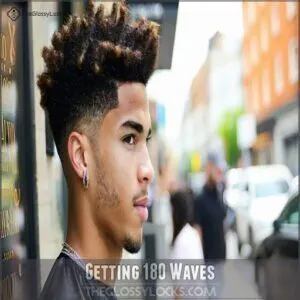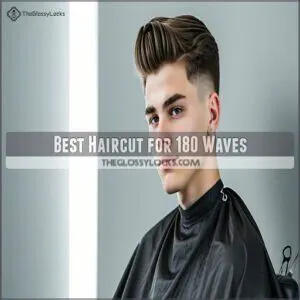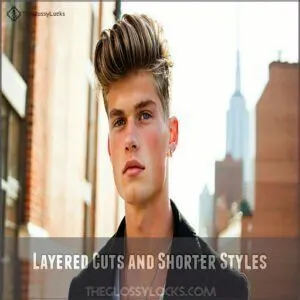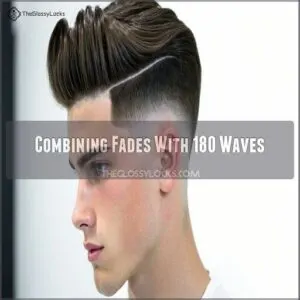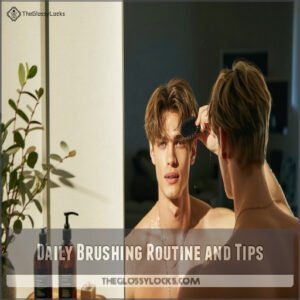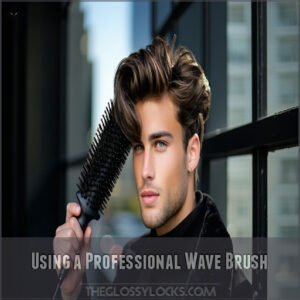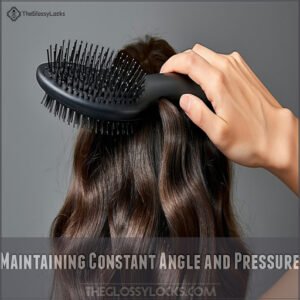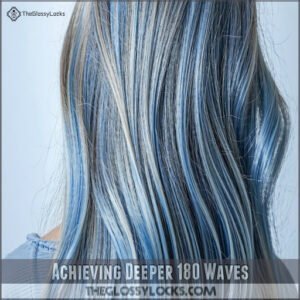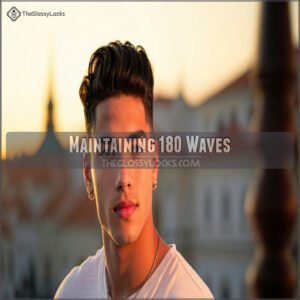This site is supported by our readers. We may earn a commission, at no cost to you, if you purchase through links.
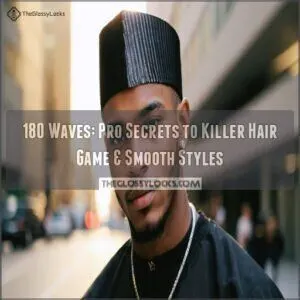
Start by getting the right cut – super short, with waves flowing smooth from your crown. You’ll need a killer routine: grab a boar bristle brush, some quality pomade, and a silky durag.
Brush consistently at the same angle, protect those waves nightly, and don’t skimp on moisture.
This isn’t just a hairstyle; it’s a cultural statement that screams confidence and personal style. Ready to level up your hair game and make waves that’ll have everyone talking?
Table Of Contents
- Key Takeaways
- What is 180 Waves
- Getting 180 Waves
- 180 Waves Haircut Ideas
- Brushing Techniques for 180 Waves
- Achieving Deeper 180 Waves
- Maintaining 180 Waves
- Frequently Asked Questions (FAQs)
- Can 180 waves cause hair loss?
- Are 180 waves suitable for straight hair?
- How long should you wolf for 180 waves?
- Can you achieve 180 waves without pomade?
- Do durag materials affect wave development?
- How much time does it take to develop waves?
- Can anyone get 180 waves regardless of hair type?
- Whats the difference between 180 and 360 waves?
- Do waves work with different hair textures naturally?
- Are special hair tools required for creating waves?
- Conclusion
Key Takeaways
- You’ll need a consistent daily brushing routine using a boar bristle brush, working from your crown outward at a precise 45-degree angle to develop crisp, defined 180 waves.
- Your wave game depends on proper hair care, including using sulfate-free products, moisturizing with natural oils like olive oil, and protecting your waves nightly with a silk or satin durag.
- Developing killer 180 waves takes patience – expect to spend 8-12 weeks of dedicated brushing and styling, with the "wolfing" technique of letting your hair grow 4-6 weeks being crucial to wave formation.
- While genetics play a role, anyone can achieve 180 waves by mastering the right techniques, investing in quality tools like wave brushes and pomade, and maintaining a disciplined hair care approach.
What is 180 Waves
Want to level up your hair game with a style that screams confidence and swagger?
180 waves are your ticket to a smooth, eye-catching look that’ll have heads turning and compliments rolling in.
Transforming your everyday hair routine into a killer statement of personal style will have a significant impact on your overall appearance.
Definition and Characteristics
From the back alleys of barbershops to the streets that define style, 180 waves are more than just a hairstyle—they’re a statement.
These precise wave patterns transform your hair into a smooth, circular masterpiece that screams confidence.
- Crisp, tight waves radiating from the crown
- Smooth hair texture that catches every eye
- A signature look that’s all about personal swagger
Cultural Impact and History
Growing from African American barber shop traditions, 180 waves aren’t just a hairstyle—they’re a cultural statement.
Your hair tells a story of resilience, self-expression, and pride.
This iconic look is achieved through diligent brushing, moisturizing, and the use of a durag, learn the waves styling process.
Rooted in social struggles and personal identity, these waves symbolize more than style; they represent a powerful journey of freedom, creativity, and unbreakable spirit in African American culture.
Hairstyle Variations and Considerations
After exploring Nas’s cultural impact, let’s zoom in on the art of 180 waves and their jaw-dropping style evolution.
Your hair’s unique texture is your canvas, and these wave patterns are about making a statement.
Check out these killer variations:
- Sleek fade with razor-sharp edges
- Deep waves that catch every glance
- Tapered legs that scream confidence
- Blond waves breaking traditional boundaries
- Design elements that tell your personal story
Buckle up for a hair transformation that’ll turn heads and make a bold statement!
Getting 180 Waves
Ready to turn heads with killer 180 waves that’ll make everyone stop and stare?
Master the art of smooth, precise hair styling by understanding the right techniques, products, and commitment needed to transform your look from basic to absolutely legendary.
This will allow you to achieve the desired look with ease and confidence.
Initial Stage and Development
Every epic wave journey starts with patience and precision in your wave formation.
Your hair’s unique texture becomes your canvas, revealing growth patterns that’ll make heads turn.
Check out this wave development roadmap:
| Week | Focus | Vibe |
|---|---|---|
| 1-2 | Routine Setup | Beginner Hustle |
| 3-4 | Wave Definition | Emerging Confidence |
| 5-6 | Refinement | Style Mastery |
| 7-8 | Consistency | Wave Domination |
Brush daily, stay committed, and watch your 180 waves transform from rough to radiant, achieving wave domination.
Choosing The Right Haircut and Products
Picking the right 180 waves haircut sets the stage for your hair game.
For a range of stylish options, explore these 180 waves haircut ideas.
You can find a variety of helpful 180 waves haircut products designed for this specific style.
Grab a 1.5 guard for a clean look, or rock a level 2 with a side taper that’ll make heads turn.
Snag a natural boar bristle wave brush, some killer pomade, and a silky durag to lock in those smooth waves and seal your style.
Styling and Maintenance Techniques
Two key ingredients make your 180 waves pop: consistent technique and killer products.
Your wave pattern isn’t just a hairstyle—it’s your personal signature.
For a detailed guide, check out this informative article on how to get 180 waves.
- Master your wave brushing routine with precision
- Choose products that match your unique hair texture
- Protect those waves with a daily maintenance ritual
Keep it smooth, keep it fresh—your wave game’s about to level up.
180 Waves Haircut Ideas
Ready to transform your hair game with killer 180 waves that’ll turn heads everywhere you go?
Whether you’re rocking a clean fade, a shorter cut, or experimenting with layered styles, you’ll learn the pro secrets to creating smooth, eye-catching waves that showcase your personal swagger.
Best Haircut for 180 Waves
Barber scissors can be your secret weapon for nailing the perfect 180 waves haircut.
Selecting the right cut transforms your look from basic to bold.
A comprehensive waves guide details all the steps and essential tools.
| Haircut Type | Ideal for |
|---|---|
| Classic Buzz | Low maintenance |
| Taper Cut | Professional style |
| Drop Fade | Versatile waves |
Pro tip: Go short with a quarter-inch guard to showcase those crisp wave patterns and keep your hair texture looking sharp.
Layered Cuts and Shorter Styles
Nailing those 180 waves with layered cuts means working your hair’s natural texture like a boss.
Short styles are your secret weapon, letting you rock clean lines and crisp waves without breaking a sweat.
Trim those sides tight, keep the top just right, and watch how your hair game transforms from basic to legendary.
Combining Fades With 180 Waves
The art of fade designs transforms your 180 waves into a masterpiece of styling precision.
A taper fade with 180 waves creates sharp, clean lines that showcase your hair texture perfectly.
Whether you’re rocking a bald fade or a subtle skin fade, these cut techniques elevate your wave patterns from basic to absolutely fire.
Brushing Techniques for 180 Waves
Ready to turn heads with killer 180 waves that’ll make everyone stop and stare?
Mastering the right brushing techniques is your secret weapon to creating smooth, perfectly defined waves that’ll have you looking like a total style boss.
Daily Brushing Routine and Tips
Since mastering 180 waves takes dedication, your daily brushing routine can make or break your hair game.
Here’s your roadmap to wave perfection:
- Start with clean, slightly damp hair
- Brush from crown outward in circular motions
- Maintain consistent 45-degree angle
- Spend 10-15 minutes per session
- Brush morning and night religiously
Commitment transforms good waves into legendary status.
Using a Professional Wave Brush
Got your wave brush ready?
Not all brushes are created equal.
Different wave brush materials and bristle types can make or break your 180 waves game.
You can find a variety of professional wave brush options online.
Pro tip: look for boar bristle brushes that match your hair texture.
They’ll help you control your wave pattern like a boss, ensuring smooth, crisp waves that’ll turn heads wherever you go.
Maintaining Constant Angle and Pressure
When mastering 180 waves, your angle and pressure are everything.
Crushing your wave game means nailing these key techniques:
- Hold your wave brush at a consistent 45-degree angle
- Apply steady, even pressure across your scalp
- Move in precise circular motions from crown to edges
- Keep your wrist locked for maximum wave pattern control
For best results, follow a detailed 180 waves guide covering essential tools and techniques.
Your technique determines your wave’s definition and shine.
Achieving Deeper 180 Waves
Ready to take your 180 waves from basic to legendary? Want those waves so smooth and defined that heads will turn wherever you go?
Wolfing Technique and Sulfate-Free Products
Kick your wave game up a notch with the wolfing technique—let your hair grow wild and free for 4-6 weeks.
This approach helps your waves connect and form a killer pattern.
You can find a variety of wolfing hair products online.
| Wolfing Stage | Key Actions |
|---|---|
| Week 1-2 | Grow, brush, protect |
| Week 3-4 | Maintain moisture, consistent brushing |
| Week 5-6 | Define wave pattern, use sulfate-free shampoo |
| Post-Wolfing | Trim, style, rock those waves |
Sulfate-free products keep your hair healthy and your waves looking sharp.
Using Hard Brushes and Wide-Tooth Combs
By week three, your wave journey demands strategic tools that transform hair into a masterpiece.
Hard brushes and wide-tooth combs become your secret weapons for epic 180 waves.
For a detailed guide, check out this informative article on 180 wave techniques.
- Select boar bristle brushes with firm, dense bristles
- Match brush material to your specific hair texture
- Invest in quality wide-tooth combs for gentle detangling
- Angle your wave brush consistently for defined patterns
- Clean and maintain brushes to preserve their effectiveness
To achieve the best results, remember that using the right tools and techniques is crucial for creating epic hair styles.
Treatment Masque and Hair Protection
After you’ve nailed your wave technique, it’s time to level up your hair game with a game-changing treatment masque.
Check out these top 5 hair repair heroes that’ll transform your waves from good to legendary:
| Product | Key Benefits |
|---|---|
| Oribe Gold Lust | Intensive nourishment |
| Philip Kingsley | Deep conditioning |
| Amika Hydro Rush | Moisture lock |
| K18 Molecular | Protein repair |
| Fekkai Strength | Damage control |
Your scalp’s about to thank you big time for this hair repair with a legendary outcome.
Maintaining 180 Waves
Want killer 180 waves that’ll turn heads and keep your style on point?
Maintaining those smooth, crisp waves takes consistent effort, but with the right routine, you’ll be rocking a fresh look that screams confidence and swagger.
Regular Haircuts and Nightly Durag Use
With scissors snipping every two weeks, keep your 180 waves sharp and defined.
Regular haircuts prevent uneven growth and maintain that crisp wave pattern, choose a skilled barber who understands your wave style.
Pair these trims with a premium durag—silk or satin works best—to protect your waves overnight and lock in that fresh, clean look.
Olive Oil for Moisture and Daily Brushing
After keeping those 180 waves tight with regular cuts, it’s time to level up your game with olive oil magic.
Your hair’s thirst for moisture is real – a few drops work wonders for scalp care and hair growth.
Grab that boar bristle brush and work the oil through, creating a smooth wave brushing routine that’ll have heads turning with moisture.
Tips for Longer-Lasting 180 Waves and Common Mistakes
After months of hustle, watch your 180 waves fade without these pro tips.
Hair breakage and product buildup can tank your wave game faster than you’d think.
Protect your scalp, control frizz, and stick to a killer brushing routine.
Your wave brushing game needs consistency, moisture, and the right technique to keep those waves looking fresh and sharp.
Frequently Asked Questions (FAQs)
Can 180 waves cause hair loss?
Aggressive brushing might stress your hair follicles, potentially causing breakage.
Be gentle with your styling routine, use soft brushes, and protect your scalp to keep those waves looking fresh without risking hair loss .
Are 180 waves suitable for straight hair?
Straight hair’s your wild card for 180 waves.
With dedication, the right products, and persistent brushing, you’ll transform those stubborn strands into rippling, head-turning waves that’ll make heads turn and jaws drop.
How long should you wolf for 180 waves?
You’ll want to wolf for about 4-6 weeks to develop killer 180 waves.
Don’t trim your hair during this time.
Brush consistently, protect with a durag, and watch those waves form like magic underneath your growing hair.
Can you achieve 180 waves without pomade?
You can rock 180 waves without pomade, but it’s tricky.
Brush consistently, use natural oils, and keep your hair moisturized.
Patience and dedication are your secret weapons for smoother, more defined waves.
Do durag materials affect wave development?
Your durag’s material definitely matters! Silk and satin smooth out waves better than cotton, reducing friction and helping you develop crisp, defined waves faster. Choose wisely for killer wave formation.
How much time does it take to develop waves?
Like riding a wave, your hair’s journey takes patience.
Depending on genetics and commitment, you’ll see initial waves in 2-4 weeks, with fully developed waves emerging around 8-12 weeks of consistent brushing and care.
Can anyone get 180 waves regardless of hair type?
You’ve got a shot at waves, no matter your hair texture.
Genetics play a role, but with patience, consistent brushing, and the right products, you’ll be styling smooth, defined waves that turn heads.
Whats the difference between 180 and 360 waves?
While 180 waves flow in one direction from crown to hairline,
they create a specific pattern.
360 waves circle your entire head like a compass, creating a more detailed and intricate wave pattern that demands extra dedication and precision.
Do waves work with different hair textures naturally?
Your natural hair texture might throw a curveball, but don’t sweat it!
With consistent brushing, the right products, and patience, you can rock waves whether you’ve got tight curls or straighter strands.
It’s all about technique.
Are special hair tools required for creating waves?
You’ll want a few key tools: a wave brush with boar bristles, a durag for nighttime protection, and pomade to keep those waves looking sharp.
Most tools are affordable and easy to find at your local beauty supply store.
Conclusion
Whether you’re rocking a tight fade or keeping it classic, 180 waves are more than just a hairstyle—they’re a statement.
Your journey to killer waves isn’t about perfection, but persistence.
Keep brushing, stay consistent, and don’t be afraid to experiment.
With the right techniques, products, and attitude, you’ll transform your hair into a head-turning masterpiece that screams confidence.
Master your 180 waves, and watch heads turn wherever you go.
- https://www.nadula.com/blog/how-long-should-you-brush-your-hair-for-180-waves/
- https://www.reddit.com/r/360Waves/comments/16mzokv/help_with_180_waves_for_a_beginner/
- https://hairmadnesssalon.com/nba-youngboy-haircut-most-popular-photos
- https://gentstylez.com/blogs/grooming/how-to-get-180-waves
- https://www.wonderopolis.org/wonder/Do-You-Need-Water-to-Make-Hair-Waves


